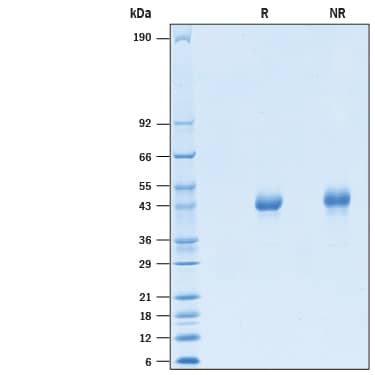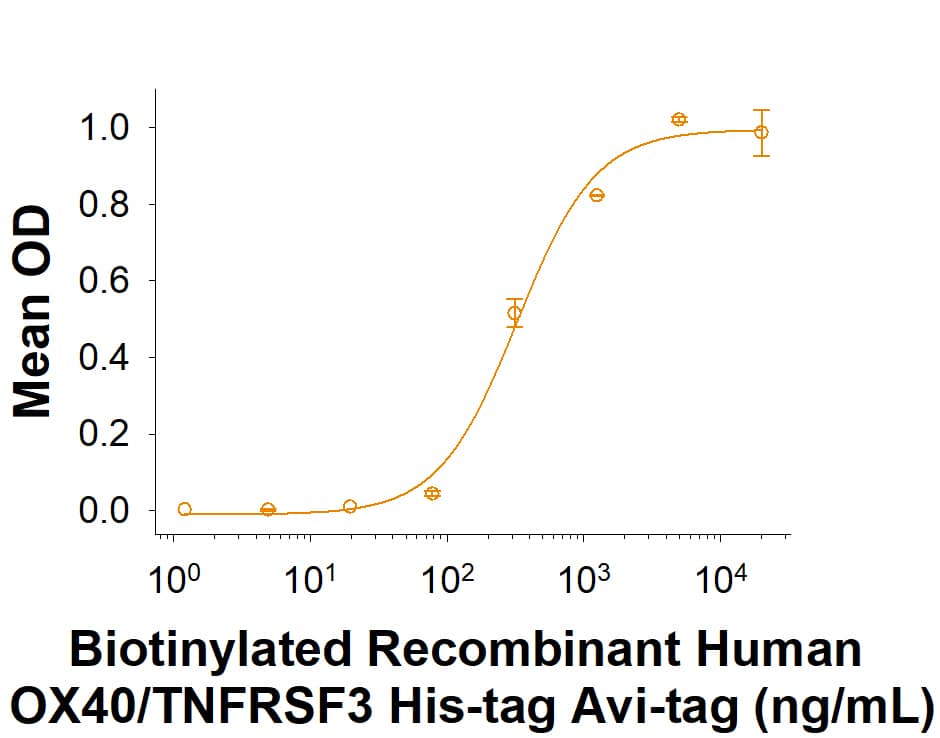Recombinant Human OX40/TNFRSF4 His-tag Avi-tag Protein, CF
R&D Systems, part of Bio-Techne | Catalog # AVI9969

Key Product Details
Source
Accession #
Structure / Form
Conjugate
Applications
Product Specifications
Source
| Human OX40/TNFRSF4 (Leu29-Ala216) Accession # P43489.1 |
7-His tag | Avi-tag |
| N-terminus | C-terminus |
Purity
Endotoxin Level
N-terminal Sequence Analysis
Predicted Molecular Mass
SDS-PAGE
Activity
Measured by its binding ability in a functional ELISA.
When Recombinant Human OX40 Ligand/TNFSF4 (Catalog # 1054-OX) is immobilized at 1.00 µg/mL (100 µL/well), Biotinylated Recombinant Human OX40/TNFRSF4 His-tag Avi-tag binds with an ED50 of 150-900 ng/mL.
Scientific Data Images for Recombinant Human OX40/TNFRSF4 His-tag Avi-tag Protein, CF
Biotinylated Recombinant Human OX40/TNFRSF4 His-tag Avi-tag Protein Binding Activity.
When Recombinant Human OX40 Ligand/TNFSF4 (1054-OX) is immobilized at 1.00 μg/mL (100 μL/well), Biotinylated Recombinant Human OX40/TNFRSF4 His-tag Avi-tag (Catalog # AVI9969) binds with an ED50 of 150-900 ng/mL.Biotinylated Recombinant Human OX40/TNFRSF4 His-tag Avi-tag Protein SDS-PAGE.
2 μg/lane of Biotinylated Recombinant Human OX40/TNFRSF4 His-tag Avi-tag (Catalog # AVI9969) was resolved with SDS-PAGE under reducing (R) and non-reducing (NR) conditions and visualized by Coomassie® Blue staining, showing bands at 40-46 kDa.Formulation, Preparation and Storage
AVI9969
| Formulation | Lyophilized from a 0.2 μm filtered solution in PBS with Trehalose. |
| Reconstitution | Reconstitute at 500 μg/mL in PBS. |
| Shipping | The product is shipped at ambient temperature. Upon receipt, store it immediately at the temperature recommended below. |
| Stability & Storage | Use a manual defrost freezer and avoid repeated freeze-thaw cycles.
|
Background: OX40
OX40 (CD134; TNFRSF4) is a T cell co-stimulatory molecule of the TNF receptor superfamily that coordinates with other co-stimulators (CD28, CD40, CD30, CD27 and 4-1BB) to manage the activation of the immune response (1-3). Human OX40 is a 48 kDa type I transmembrane glycoprotein with a 28 amino acid (aa) signal sequence, a 185 aa extracellular domain (ECD) that contains a cysteine-rich region, a 20 aa transmembrane segment, and a 41 aa cytoplasmic domain (4). The ECD of human OX40 shares 63% sequence identity with the ECD of mouse and rat OX40. OX40 is up-regulated on CD4+ and CD8+ T cells upon engagement of the TCR by antigen presenting cells along with co-stimulation by CD40-CD40 Ligand and CD28-B7 (5, 6). OX40 Ligand is primarily expressed on antigen presenting cells (5). OX40 Ligand engagement of OX40 on activated CD4+ T cells results in increased T cell survival, proliferation, and cytokine production. It also inhibits the conversion of effector T cells into immunosuppressive regulatory T cells (Tregs) and can promote the maintenance of and recall response in memory T cells (3, 7-10). OX40 is constitutively expressed on Tregs and enhances the sensitivity of Tregs to IL-2, thus promoting Treg proliferation. OX40 has also been shown to decrease the cells' immunosuppressive activity on effector T cells (11-14). OX40-OX40 Ligand signaling is involved in allergic airway inflammation, graft-versus-host disease and autoimmune disease (6, 15, 16). Mutations in OX40 and OX40 Ligand are associated with cardiovascular disease (17, 18). Our Avi-tag Biotinylated human OX40/TNFRSF4 Hi-tag features biotinylation at a single site contained within the Avi-tag, a unique 15 amino acid peptide. Protein orientation will be uniform when bound to streptavidin-coated surface due to the precise control of biotinylation and the rest of the protein is unchanged so there is no interference in the protein's bioactivity.
References
- Hori, T. (2006) Int. J. Hematol. 83:17.
- Latza, U. et al. (1994) Eur. J. Immunol. 24:677.
- Salek-Ardakani, S. et al. (2003) J. Exp. Med. 198:315.
- al-Shamkhani, A. et al. (1996) Eur. J. Immunol. 26:1695.
- Moran, A.E. et al. (2013) Curr. Opin. Immunol. 25:230.
- Gramaglia, I. et al. (1998) J. Immunol. 161:6510.
- Xiao, X. et al. (2008) J. Immunol. 181:3193.
- So, T. and M. Croft (2007) J. Immunol. 179:1427.
- Mousavi, S.F. et al. (2008) J. Immunol. 181:5990.
- Bansal-Pakala, P. et al. (2001) Nat. Med. 7:907.
- Piconese, S. et al. (2010) Eur. J. Immunol. 40:2902.
- Griseri, T. et al. (2010) J. Exp. Med. 207:699.
- Xiao, X. et al. (2012) J. Immunol. 188:892.
- Vu, M.D. et al. (2007) Blood 110:2501.
- Damayanti, T. et al. (2010) Am. J. Respir. Crit. Care Med. 181:688.
- Xiao, X. et al. (2012) Nat. Immunol. 13:981.
- Nakano, M. et al. (2010) Cardiovasc. Res. 88:539.
- Ishii, N. et al. (2010) Adv. Immunol. 105:63.
- Godfrey, W.R. et al. (1994) J. Exp. Med. 180:757.
Alternate Names
Gene Symbol
UniProt
Additional OX40 Products
Product Documents for Recombinant Human OX40/TNFRSF4 His-tag Avi-tag Protein, CF
Product Specific Notices for Recombinant Human OX40/TNFRSF4 His-tag Avi-tag Protein, CF
For research use only

